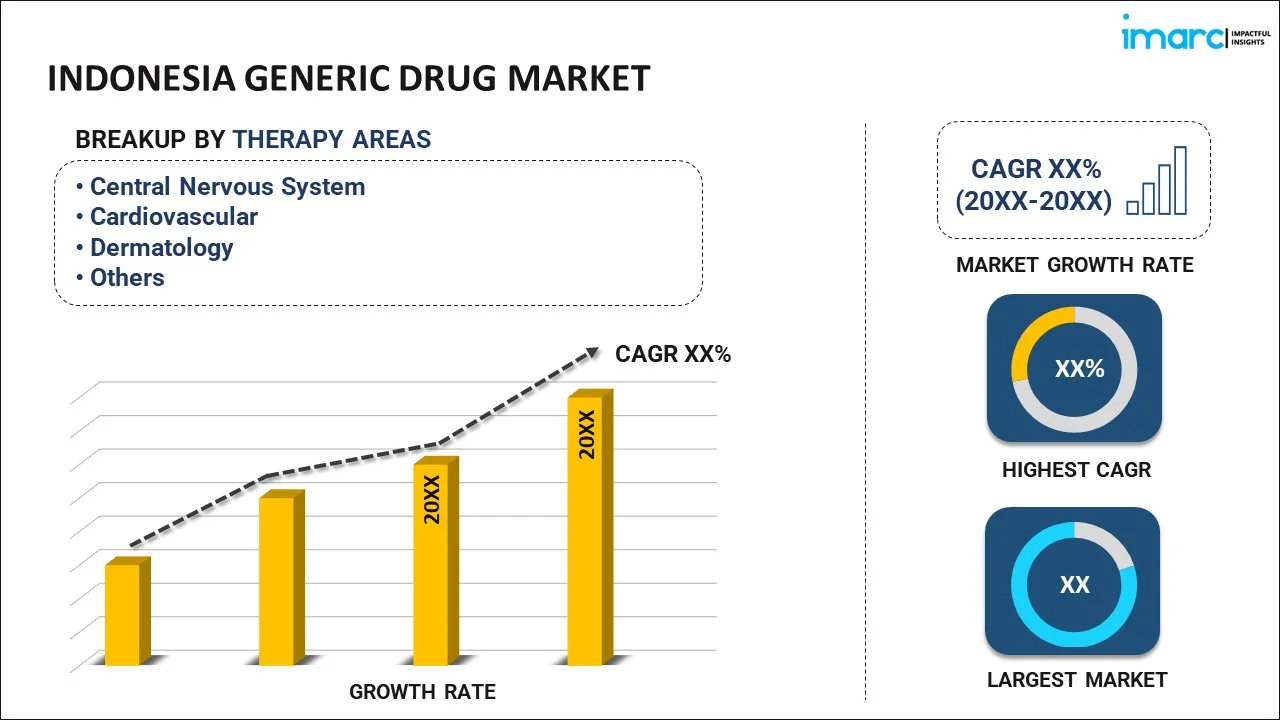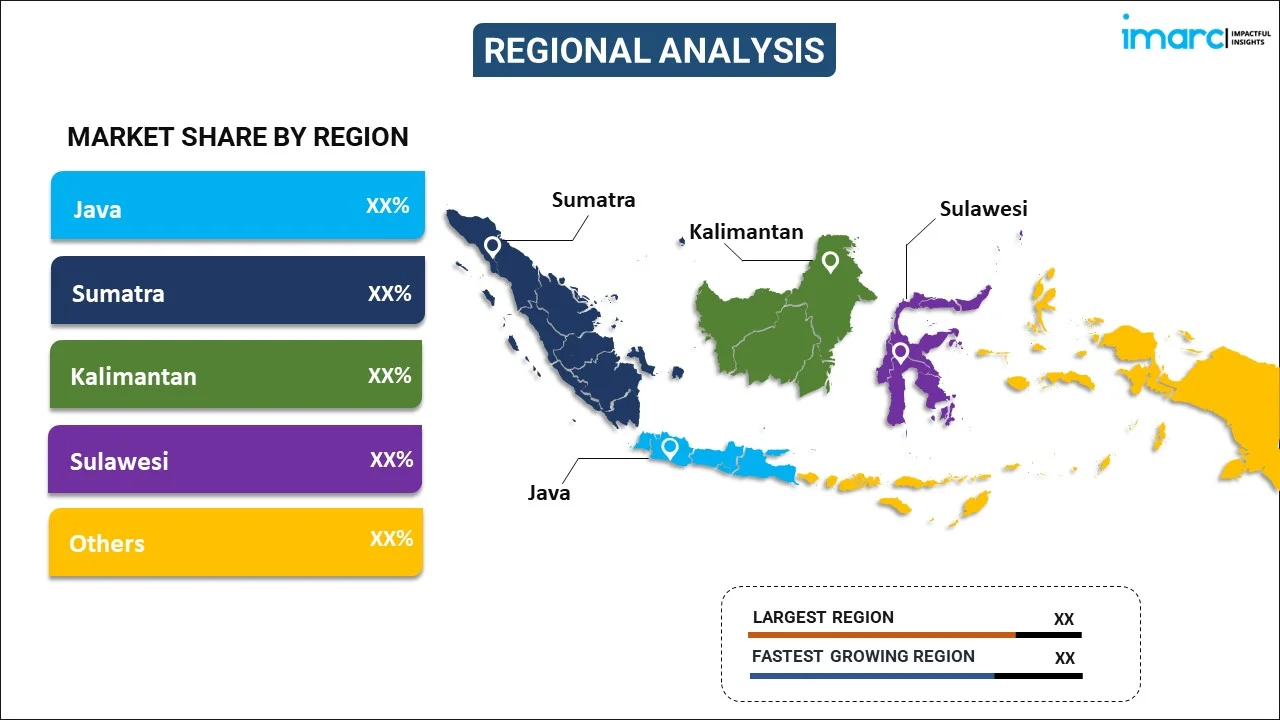
Indonesia Generic Drug Market Report by Therapy Area (Central Nervous System, Cardiovascular, Dermatology, Genitourinary/Hormonal, Respiratory, Rheumatology, Diabetes, Oncology, and Others), Drug Delivery (Oral, Injectables, Dermal/Topical, Inhalers), Distribution Channel (Retail Pharmacies, Hospital Pharmacies), and Region 2025-2033
Market Overview:
The Indonesia generic drug market size reached USD 5.0 Billion in 2024. Looking forward, IMARC Group expects the market to reach USD 9.9 Billion by 2033, exhibiting a growth rate (CAGR) of 7.87% during 2025-2033. The growing population and the rising demand for healthcare services, the significant expansion of the pharmaceutical industry, the growing awareness of health-related issues, and the importance of proper medication represent some of the key factors driving the market.
|
Report Attribute
|
Key Statistics
|
|---|---|
|
Base Year
|
2024
|
|
Forecast Years
|
2025-2033
|
|
Historical Years
|
2019-2024
|
|
Market Size in 2024
|
USD 5.0 Billion |
|
Market Forecast in 2033
|
USD 9.9 Billion |
| Market Growth Rate 2025-2033 | 7.87% |
A generic drug is a medication that is equivalent to a brand-name drug in terms of active ingredients, quality, dosage, and intended use. It is typically produced and sold after the patent protection for the original brand-name drug has expired. It offers a cost-effective alternative to its brand-name counterparts, making healthcare more affordable for consumers. It has the same active ingredients as the brand-name drugs they are developed to mimic that have the same therapeutic effect on the body. It undergoes rigorous testing by regulatory authorities to ensure they are safe and effective and must encounter the same quality and safety standards as brand-name drugs. It must be approved by the government before they can be marketed and sold. The government reviews data to confirm that the generic drug is equal to the brand-name drug in terms of quality and effectiveness. Additionally, it is available in various dosage forms, including tablets, capsules, injections, and topical creams, including brand-name drugs, allowing patients to have options to choose the form that best suits their needs. Also, prescription and over-the-counter (OTC) medications can have generic counterparts, offering consumers more affordable options for self-treatment. Nowadays, manufacturers can produce and sell their versions of the drug, increasing competition and further driving down prices.
Indonesia Generic Drug Market Trends:
The market is primarily driven by the growing population and the escalating demand for healthcare services and pharmaceuticals, including generic drugs. In addition, the Indonesian government is actively promoting the use of generic drugs as part of its efforts to make healthcare more reasonable and accessible to its citizens, with various policies and regulations to promote the production and consumption of generic medicines, contributing to the market growth. Moreover, the pharmaceutical industry in Indonesia is experiencing significant growth, with domestic and international companies investing in manufacturing facilities, influencing the availability of generic drug options, representing another major growth-inducing factor. Besides this, the awareness of health-related issues and the importance of proper medication has grown among the Indonesian population, escalating the demand for affordable and effective pharmaceutical solutions such as generic drugs, which is accelerating market growth. Along with this, generic drugs are typically more affordable than their branded counterparts, which is appealing to most Indonesians, who may have limited financial resources for healthcare expenses, further propelling the market growth. Additionally, the increasing domestic production of generic drugs reduces the country's reliance on imported medications, ensuring a stable supply of generic drugs, which is augmenting the market growth. Furthermore, the patents for many branded drugs have expired, which offers the opportunity for generic drug manufacturers to enter the market, creating a positive market outlook.
Indonesia Generic Drug Market Segmentation:
IMARC Group provides an analysis of the key trends in each segment of the market, along with forecasts at the country level for 2025-2033. Our report has categorized the market based on therapy area, drug delivery, and distribution channel.
Therapy Area Insights:

- Central Nervous System
- Cardiovascular
- Dermatology
- Genitourinary/Hormonal
- Respiratory
- Rheumatology
- Diabetes
- Oncology
- Others
The report has provided a detailed breakup and analysis of the market based on the therapy area.. This includes central nervous system, cardiovascular, dermatology, genitourinary/hormonal, respiratory, rheumatology, diabetes, oncology, and others.
Drug Delivery Insights:
- Oral
- Injectables
- Dermal/Topical
- Inhalers
A detailed breakup and analysis of the market based on the drug delivery have also been provided in the report. This includes oral, injectables, dermal/topical, and inhalers.
Distribution Channel Insights:
- Retail Pharmacies
- Hospital Pharmacies
The report has provided a detailed breakup and analysis of the market based on the distribution channel. This includes retail pharmacies and hospital pharmacies.
Regional Insights:

- Java
- Sumatra
- Kalimantan
- Sulawesi
- Others
The report has also provided a comprehensive analysis of all the major regional markets, which include Java, Sumatra, Kalimantan, Sulawesi, and Others.
Competitive Landscape:
The market research report has also provided a comprehensive analysis of the competitive landscape in the market. Competitive analysis such as market structure, key player positioning, top winning strategies, competitive dashboard, and company evaluation quadrant has been covered in the report. Also, detailed profiles of all major companies have been provided.
Indonesia Generic Drug Market Report Coverage:
| Report Features | Details |
|---|---|
| Base Year of the Analysis | 2024 |
| Historical Period | 2019-2024 |
| Forecast Period | 2025-2033 |
| Units | Billion USD |
| Scope of the Report | Exploration of Historical and Forecast Trends, Industry Catalysts and Challenges, Segment-Wise Historical and Predictive Market Assessment:
|
| Therapy Areas Covered | Central Nervous System, Cardiovascular, Dermatology, Genitourinary/Hormonal, Respiratory, Rheumatology, Diabetes, Oncology, Others |
| Drug Deliveries Covered | Oral, Injectables, Dermal/Topical, Inhalers |
| Distribution Channels Covered | Retail Pharmacies, Hospital Pharmacies |
| Regions Covered | Java, Sumatra, Kalimantan, Sulawesi, Others |
| Customization Scope | 10% Free Customization |
| Post-Sale Analyst Support | 10-12 Weeks |
| Delivery Format | PDF and Excel through Email (We can also provide the editable version of the report in PPT/Word format on special request) |
Key Questions Answered in This Report:
- How has the Indonesia generic drug market performed so far and how will it perform in the coming years?
- What has been the impact of COVID-19 on the Indonesia generic drug market?
- What is the breakup of the Indonesia generic drug market on the basis of therapy area?
- What is the breakup of the Indonesia generic drug market on the basis of drug delivery?
- What is the breakup of the Indonesia generic drug market on the basis of distribution channel?
- What are the various stages in the value chain of the Indonesia generic drug market?
- What are the key driving factors and challenges in the Indonesia generic drug?
- What is the structure of the Indonesia generic drug market and who are the key players?
- What is the degree of competition in the Indonesia generic drug market?
Key Benefits for Stakeholders:
- IMARC’s industry report offers a comprehensive quantitative analysis of various market segments, historical and current market trends, market forecasts, and dynamics of the Indonesia generic drug market from 2019-2033.
- The research report provides the latest information on the market drivers, challenges, and opportunities in the Indonesia generic drug market.
- Porter's five forces analysis assist stakeholders in assessing the impact of new entrants, competitive rivalry, supplier power, buyer power, and the threat of substitution. It helps stakeholders to analyze the level of competition within the Indonesia generic drug industry and its attractiveness.
- Competitive landscape allows stakeholders to understand their competitive environment and provides an insight into the current positions of key players in the market.
Need more help?
- Speak to our experienced analysts for insights on the current market scenarios.
- Include additional segments and countries to customize the report as per your requirement.
- Gain an unparalleled competitive advantage in your domain by understanding how to utilize the report and positively impacting your operations and revenue.
- For further assistance, please connect with our analysts.
 Inquire Before Buying
Inquire Before Buying
 Speak to an Analyst
Speak to an Analyst
 Request Brochure
Request Brochure
 Request Customization
Request Customization




.webp)




.webp)












